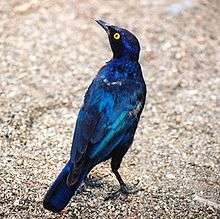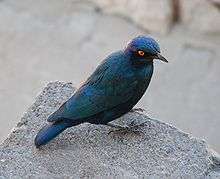Cape starling
| Cape starling | |
|---|---|
 | |
| Scientific classification | |
| Kingdom: | Animalia |
| Phylum: | Chordata |
| Class: | Aves |
| Order: | Passeriformes |
| Family: | Sturnidae |
| Genus: | Lamprotornis |
| Species: | L. nitens |
| Binomial name | |
| Lamprotornis nitens (Linnaeus, 1766) | |
| Synonyms | |
|
Turdus nitens Linnaeus, 1766 | |
The Cape starling, red-shouldered glossy-starling or Cape glossy starling (Lamprotornis nitens) is a species of starling in the family Sturnidae. It is found in southern Africa, where it lives in woodlands, bushveld and in suburbs.[2]
Taxonomy
In 1760 the French zoologist Mathurin Jacques Brisson included a description of the Cape starling in his Ornithologie based on a specimen collected in Angola. He used the French name Le merle verd d'Angola and the Latin Merula Viridis Angolensis.[3] Although Brisson coined Latin names, these do not conform to the binomial system and are not recognised by the International Commission on Zoological Nomenclature.[4] When in 1766 the Swedish naturalist Carl Linnaeus updated his Systema Naturae for the twelfth edition, he added 240 species that had been previously described by Brisson.[4] One of these was the Cape starling. Linnaeus included a brief description, coined the binomial name Turdus nitens and cited Brisson's work.[5] The specific name nintens is Latin for "shining" or "glittering".[6] This species is now placed in the genus Lamprotornis that was introduce by the Dutch zoologist Coenraad Jacob Temminck in 1820.[7] There are no recognised subspecies.[8]
Description
The Cape starling has an adult length of about 25 cm (10 in) and weight of about 100 grams (3.5 oz). The plumage is a fairly uniform bright, glossy colour. The head is blue with darker ear coverts and the upper parts of the body are greenish-blue. It has a lengthy warbling song which may include an imitation of sounds it hears in its environment.[9]
Distribution and habitat

The Cape starling is found in the southern part of Africa. Its range encompasses the extreme south of Gabon, the west and south of Angola, the extreme south of Zambia, the southern half of Zimbabwe, Namibia, Botswana, Lesotho and South Africa. It is a vagrant to the Republic of the Congo but does not breed there. In the other countries in its range it is a resident (non-migratory) species and its total extent of occurrence is about 3,000,000 square kilometres (1,200,000 sq mi).[10] The Cape starling is found where trees in which it can roost and nest are found. It is not a bird of dense forest or of pasture and is not associated with any particular plant type. It does occur in open woodland, plantations, savannah, bushveld, rough grassland, parks and gardens and is quite numerous in the central Kalahari where isolated trees occur.[11]
Behaviour
The Cape starling is a gregarious bird and forms large flocks in the non-breeding season. It usually feeds on the ground often foraging alongside other species of starlings such as the pied starling, the common starling, the greater blue-eared starling, the lesser blue-eared starling, the wattled starling and Burchell's starling.[11] It is habituated to humans and its diet includes fruit, insects and nectar. It sometimes feeds on ectoparasites that it picks off the backs of animals and it sometimes visits bird tables for scraps.[12]
Breeding mainly takes place between October and February but may continue into April in Namibia. It nests in crevices such as holes in trees and out-competes other birds seeking to use these holes. It is a host to the greater honeyguide, a brood parasite that lays its eggs in other birds' nests.[11] In an observed nest in a thorn tree at the edge of the Kalahari, the chicks were fed predominantly on grasshoppers, locusts, ants and beetles, and were also given fruit, insect larvae and other small invertebrates.[12]
References
- ↑ BirdLife International (2012). "Lamprotornis nitens". IUCN Red List of Threatened Species. Version 2013.2. International Union for Conservation of Nature. Retrieved 2013-11-26.
- ↑ Collins Illustrated Checklist, Ber van Perlo, ISBN 0 00 220117 8
- ↑ Brisson, Mathurin Jacques (1760). Ornithologie, ou, Méthode contenant la division des oiseaux en ordres, sections, genres, especes & leurs variétés (in French and Latin). Volume 2. Paris: Jean-Baptiste Bauche. pp. 311–312, Plate 30 fig 2. The two stars (**) at the start of the section indicates that Brisson based his description on the examination of a specimen.
- 1 2 Allen, J.A. (1910). "Collation of Brisson's genera of birds with those of Linnaeus". Bulletin of the American Museum of Natural History. 28: 317–335.
- ↑ Linnaeus, Carl (1766). Systema naturae : per regna tria natura, secundum classes, ordines, genera, species, cum characteribus, differentiis, synonymis, locis (in Latin). Volume 1, Part 1 (12th ed.). Holmiae (Stockholm): Laurentii Salvii. p. 294.
- ↑ Jobling, J.A. (2018). del Hoyo, J.; Elliott, A.; Sargatal, J.; Christie, D.A.; de Juana, E., eds. "Key to Scientific Names in Ornithology". Handbook of the Birds of the World Alive. Lynx Edicions. Retrieved 11 May 2018.
- ↑ Temminck, Coenraad Jacob (1820). Manuel d'ornithologie, ou, Tableau systématique des oiseaux qui se trouvent en Europe (in French). Part 1 (2nd ed.). Paris: H. Cousin. p. 55 (LV).
- ↑ Gill, Frank; Donsker, David, eds. (2018). "Nuthatches, Wallcreeper, treecreepers, mockingbirds, starlings, oxpeckers". World Bird List Version 8.1. International Ornithologists' Union. Retrieved 11 May 2018.
- ↑ del Hoyo, J.; Elliott, A.; Sargatal, J.; Christie, D.A.; de Juana, E. (eds.). "Cape glossy starling". Handbook of the Birds of the World Alive. Lynx Edicions. Retrieved 2014-09-09.
- ↑ Butchart, S.; Ekstrom, J. "Species factsheet: Lamprotornis nitens". BirdLife International. Retrieved 2014-09-09.
- 1 2 3 Craig, A.J.F.K. "Glossy starling: Kleinglansspreeu (Lamprotornis nitens)" (PDF). The Atlas of Southern African Birds. Retrieved 2014-09-09.
- 1 2 Lerm, Rion E. (2014). "The breeding ecology of Cape glossy starlings at a nest site in the Kalahari". Ornithological Observations. 5: 37–40. ISSN 2219-0341.
External links

